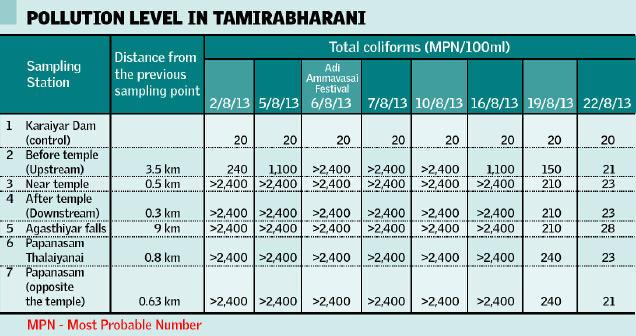Alarming levels of pollution in the Tamirabharani

A study by a team of experts in the Tamirabharani upstream before and after ‘Aadi amaavaasai’ festival held at Sorimuthu Ayyanar Temple in the Kalakkad–Mundanthuri Tiger Reserve (KMTR) in the Western Ghats has revealed that uncontrolled open defecation and irrepressible dumping of sacrificed animal waste have greatly polluted the waters with the faecal coliform bacteria content rising to alarming levels during the annual feast.
As thousands of devotees stay deep inside the jungle around the temple in the KMTR for over a week as part of the annual ‘Aadi amaavaasai’ celebrations, the immense pressure exerted by the people on nature badly affects the environment, particularly the 120-km-long Tamirabharani river, which nourishes a range of crops, especially paddy, on over 1 lakh acres, and quenches the thirst of several millions of people in four districts – Tirunelveli, Kanyakumari, Turicorin and Virudhunagar.
Since this river is getting seriously polluted every year during the ‘Aadi amaavaasai’ celebrations held in the temple, a team of researchers, led by renowned toxicologist and environmental scientist A.G.Murugesan, Professor, Sri Paramakalyani Centre for Excellence in Environmental Science, Manonmaniam Sundaranar University, Alwarkurichi, conducted a comprehensive study before and after the celebrations in vulnerable areas, to assess the coliform bacteria content in the upstream and downstream of the river from the location of the temple. They have been conducting the study for several years.
Water samples were scientifically collected from seven different points along the Tamirabharani, starting from Karaiyar dam to Papanasam, before and after the festival. According to their studies, the river water near the Sorimuthu Ayyanar Temple contains total and faecal coliforms to unacceptable levels and the situation is worsening year after year.
The term ‘total coliforms’ refers to a large group of gram-negative, rod-shaped bacteria that includes thermo-tolerant coliforms and bacteria of faecal origin and bacteria from environmental sources.
During 2004–2006, the total coliform bacterial population was found in the range of 844–1,100 MPN (Most Probable Number)/100ml of water near the temple and at Papanasam. The total coliform was found to be 20 MPN/100ml near Karaiyar dam, and there is no faecal coliform in the area throughout the study period – from August 2, 2013 to August 22, 2013.
But in the upstream (0.5 km ahead of the Sorimuthu Ayyanar Temple), the total and faecal coliform levels were recorded as 240–1,100 MPN/100ml and 150–460 MPN/100ml respectively, before the festival this year (August 6).
From August 6 to August 10, the total and faecal coliform levels were greater than 2,400 MPN/100ml invariably at all the sampling points.
“Since we’ve got limited facilities, we can measure up to 2,400 MPN, and hence the actual number of coilform bacteria in the Tamirabharani can be even more than a million. If we’ve got sophisticated equipment, we can measure the exact number,” Dr.Murugesan says.
On August 16, the faecal coliform content came down to 1,100 MPN/100ml near and after the temple, but it was above 2400 MPN/100 ml at Papanasam.
The total coliform level was also found to be more than 2400 MPN/100ml from the temple up to Papanasam.
On August 19, the faecal coliform was much reduced to the range of 64–210 MPN/100ml while the total coliform was recorded as 150–240 MPN/100ml.
The indiscriminate human activities such as open defecation, dumping of sacrificed animal waste and mass bathing are responsible for the elevated levels of the pathogenic bacteria. If left unnoticed, this may pose a great risk to human health, leading to diarrhoea, fever, headache and other secondary complications, warns Dr.Murugesan.
Faecal and total coliform counts are the most commonly used indicators in assessing the pathological quality of water. Presence of this organism is regarded as an indication of faecal pollution and possibility of the presence of other enteric pathogens. People suffering from communicable diseases also discharge pathogenic microbes in the water in the form of excreta, and the higher the level of faecal contamination the greater will be the threat of waterborne diseases.
As per the guidelines of the Central Pollution Control Board and World Health Organization, the standard values are 50 MPN/100ml for total coliform, and 0 MPN/100ml for faecal coliform in water used for drinking purpose.
Dr.Murugesan suggests that strict measures should be taken to improve sanitation, awareness must be created about the quality of water, and pollution of river water should be stopped.
“Authorities should restrict religious activities to one or two days, instead of permitting the pilgrims to stay in the forest area for a week or so. Temporary, permanent or mobile latrines should be set up in adequate numbers and they should be properly maintained during the festival. Separate places should be identified for animal sacrifice in a controlled manner and provisions should be made to remove the animal waste immediately,” he insists.
You can return to the main Market News page, or press the Back button on your browser.

